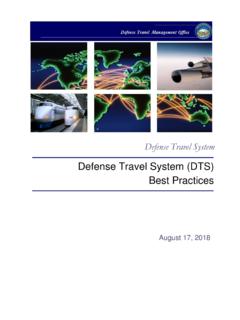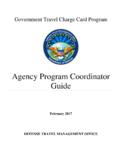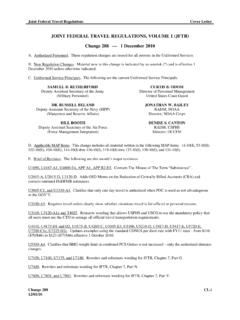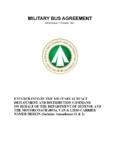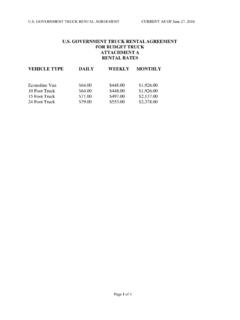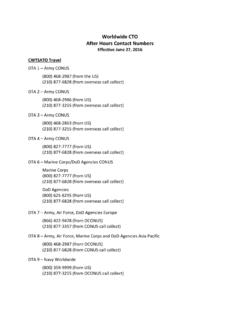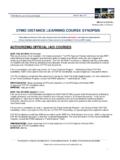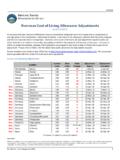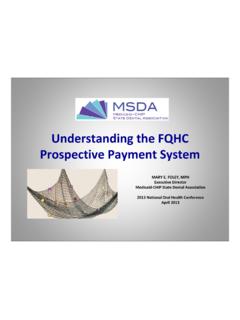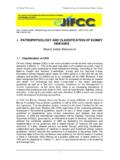Transcription of Traveler Instructions to Create a Local Voucher
1 This document maintained on the DTMO website at Printed copies may be obsolete. 1 6 5 Accounting On the navigation bar, select Accounting, then: 1. Select an available LOA. 2. If you need more than one LOA: a. Select additional LOAs and acknowledge the pop-up message(s) about allocating expenses. b. From How To Allocate, choose an allocation method, then select Allocate Expenses. c. Allocate the expenses among the LOAs, then select Save Allocations. The right column displays all selected LOAs and a breakdown of the expenses being charged to each. Additional Options On the navigation bars, select Additional Options, then select: 1. Comments to enter comments to the Authorizing Official (AO). 2. Payment Totals to edit the split disbursement so the GTCC vendor receives the amount you owe. In the Add l GOVCC Amt field, enter the amount of GTCC charges not separately reimbursed on the Voucher ( , restaurant meals).
2 3. Profile to edit your DTS profile. Review / Sign 1. Select Review/Sign > Preview in the navigation bars to review all the information in the Local Voucher . 2. If you find an error, select an Edit link to fix it. 3. Select Pre-Audit to review and justify all flagged items, then select Save and Proceed To Digital Signature. 4. Ensure the Submit this document as option is SIGNED. 5. Ensure the correct Routing List displays. 6. (Optional) Enter Additional Remarks to the AO. 7. Select Submit Completed Document. 8. Acknowledge all pop-ups, and if prompted for your CAC PIN, enter it. From the DTS Dashboard, select Local Vouchers in the left column of the My Travel Documents section to display your Local vouchers, then: 1. Select Edit next to a Local Voucher . 2. Depending on the circumstances, you may have to take one or more of the following steps before the Local Voucher opens: a. Clear the Open Document VIEW-ONLY check box, then select OK.
3 B. Enter your CAC PIN, then select OK. c. Enter Comments, then select OK. 3. Make all necessary changes. 4. Sign the Local Voucher (see Section 6). August 17, 2018 For more info, see DTS Guide 4: Local Vouchers at A Local Voucher is a request for the reimbursement for expenses incurred and the payment of allowances earned while conducting official business near your Permanent Duty Station (PDS). Log On to DTS 1. Insert the CAC into the reader. 2. Access the DTS Home page at 3. Select Log In. 4. Read and Accept the DoD Privacy & Ethics Policy. 5. Enter your CAC PIN, then select OK. Create a Local Voucher 1. On the DTS Dashboard, select Create New Document, then Local Voucher . 2. Enter the Local Voucher Date. It defaults to the current date, but you can change it to a past date. Since a Local Voucher is claim for completed travel, you cannot select a future date.
4 3. For Is this for Conference Attendance, select Yes or No, and if Yes, identify the Conference/Event Name, then select OK. The Non-Mileage Expenses module opens. Note: You may claim expenses for multiple events on one Local Voucher as long as every event ended before or on the date you entered as the Local Voucher Date. 6 5 Edit Local Vouchers 4 Create a Local Voucher : Instructions for Travelers DEFENSE TRAVEL MANAGEMENT OFFICE 4 3 2 Non-Mileage Expenses Add Manually In the navigation bars, select Expenses > Non-Mileage, then: 1. In the left column, for each non-mileage expense, select an Expense Type. If the expense type is not listed, type it in the -OR- field. 2. Enter an event in the Event Purpose field. Typing an event adds it to a drop-down list for future use. 3. Complete the remaining fields expense Cost, Date incurred, and Method of Reimbursement. 4. Select Save Expenses. You can initially add two expenses at once, then add others one at a time.
5 Note: For any expense of $75 or more, a pop-up opens to remind you that a receipt is required. Acknowledge the pop-up. Use the links in the right column to edit, remove, or copy saved expenses. Add from a Government Travel Charge Card (GTCC) Data To add a GTCC transaction to your Local Voucher , select the link pictured above (it s below the yellow information panel at the top of the screen), then the Add link next to the expense you intend to claim. You may have to select an Expense Type before you save it. Mileage Allowances The most common types of mileage allowances on a Local Voucher are: In-and-Around Mileage begins and ends at the event location. Private Auto (or Motorcycle) Mileage begins or ends at your PDS or residence. In the navigation bars, select Expenses > Mileage, then: To enter in-and-around mileage: 1. Select Private Auto or Private Motorcycle as the Expense Type. 2. Verify or enter the Event Purpose.
6 3. Enter the event Location. 4. Verify or enter the Date field of the expense. 5. Enter the number of Miles you drove, then select Save Expenses. You can initially add two mileage allowances at once, then add others one at a time. Use the links in the right column to edit, remove, or copy saved expenses. To enter private auto mileage: 1. Select Private Auto Mileage- Owner/Operator or Private Motorcycle Mileage- Owner/Operator as the Expense Type. 2. Verify or enter the Event Purpose. 3. Enter the From and To locations for this travel leg or select them from Profile Locations. If you select Duty Station, skip to Step 6. If you select Residence, new fields appear. 4. Select how you usually commute: If you usually drive, select Normal one-way mileage. Otherwise, select Daily one-way commuting cost. 5. Enter the mileage or cost of your daily commute. 6. Enter the event Date and the number of Miles for this travel leg.
7 7. To quickly Create a second travel leg showing a return to your From point, check the ..separate expense for round trip box. 8. Select Save Expenses. You can initially add two mileage allowances at once, then add others one at a time. Use the links in the right column to edit, remove, or copy saved allowances. Substantiating Records To add supporting documents ( , receipts) to the Local Voucher , in the navigation bars select Expenses > Substantiating Records, then: Attach Paper Documents To Create and attach an electronic image of a paper document to your Voucher : 1. Select Fax Cover Sheet, then print the cover sheet. 2. Follow the Instructions on the cover sheet. 3. When the attachment appears under Existing Receipts, enter descriptive Notes about the attached record, then select Save Notes. Notes: 1. The cover sheet must be placed on top of all other documents when faxing. 2. A cover sheet is unique to a specific Local Voucher ; be sure to use one for the correct Local Voucher .
8 Upload Electronic Images 1. Select Browse, then choose a file to upload. 2. Select Upload. Once the file is uploaded, a Notes field displays. 3. When the attachment appears under Existing Receipts, enter descriptive Notes about the attached record, then select Save Notes. 1 2 3
